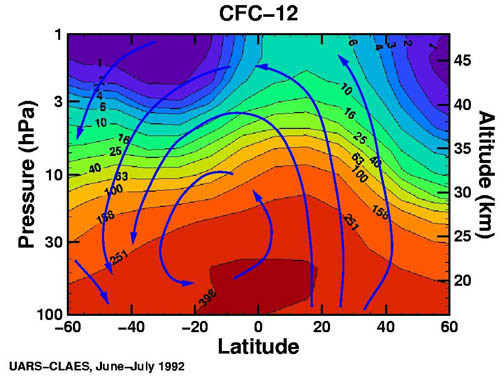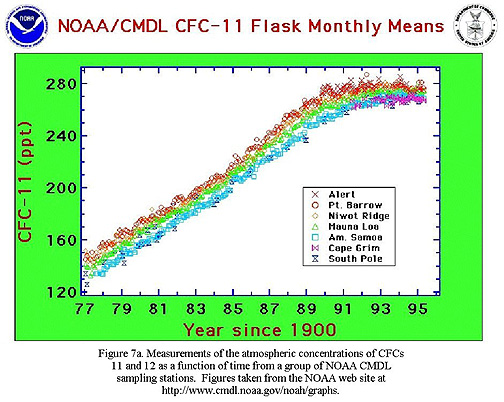OZONE DEPLETION AND CFC THEORY by S. Fred Singer Science, September 1993
1. Gary Taubes' article ("The Ozone Backlash," Science, June 11, pp 1580-1583) refers to my commentaries as "purporting to shoot holes in the [CFC] theory of ozone depletion." This is hardly necessary; since March 1988 numerous press releases have announced ozone depletion to be "worse than expected" [from the theory]--thus effectively discrediting it.
My comments have pointed to the lack--so far--of convincing observational evidence for long-term ozone depletion:
The data from ground-based observing stations are reported to be contaminated by UV absorption from atmospheric sulfur dioxide (1).
The statistical treatment is inadequate, with the derived "trend" strongly dependent on the time interval selected for analysis (2).
There is also the problem of disentangling any CFC effects from long-term ozone trends of natural origin, correlated with well-recorded trends in sunspot numbers (3).
Obviously, one cannot exclude the possibility of a long-term depletion of ozone due to anthropogenic causes, and specifically due to CFCs. But with each cause producing its characteristic "finger prints," proof must rely on a longer time series of more detailed observations (of CFC-specific altitude, latitude, and seasonal dependence). 2. While skeptical about the evidence for depletion, I consider the Antarctic ozone "hole" to be a genuine phenomenon, but have held a somewhat different view about its future. I have speculated (4) that--once there is sufficient chlorine present--the intensity of the hole is mainly controlled by the presence of polar stratospheric clouds (PSCs), and therefore by temperature and humidity rather than just atmospheric CFC concentration. Because the ongoing increase in atmospheric CO2 should gradually lower stratospheric temperatures (as a result of increased radiation loss), and the increase in methane should gradually increase stratospheric water vapor content (5), it is possible that the hole will persist--even if the chlorine concentration falls below the pre-1975 value. We don't know for certain where the chlorine threshold lies; it is possible therefore that an ozone hole could form in the Arctic if climate conditions favor the formation of PSCs there--even in the absence of CFC-produced chlorine (4).
3. Another controversial issue is covered by Taubes and in an adjacent article (6): What are the relative contribu- tions of natural and human sources to stratospheric chlorine? One side claims that the major sources are volcanic (7,8). The other side criticizes these estimates, arguing that nearly all of the chlorine emitted by volcanic and oceanic sources is washed out in the lower atmosphere, "with negligible quantities reaching the stratosphere" (9). A recent paper (10) claims removal of "up to" four orders of magnitude; but Taubes relates that El Chichon increased global stratospheric chlorine by 10 percent. I conclude that reliable statements about the relative effects of natural and human sources should be based on observed trends of stratospheric chlorine rather than on speculative calculations.
Rowland correctly quotes my views on sources of chlorine as of 1988 (11), but does not cite the relevant 1987 papers by Zander et al (12). They found that the total columns of HCl and HF (the major stratospheric reservoir gases for chlorine and fluorine) increased, from 1977 to 1986, at rates of (0.75 + 0.2)% and (8.5 + 1)% per year, respectively. Since HF is ascribed entirely to CFCs, the much lower trend for HCl would lead one to believe that there are large natural sources of stratospheric chlorine that overwhelm the CFC contribution.
This situation changed in 1991, however, when Curtis Rinsland et al, repeating Zander's measurements of solar IR spectra, reported increases for HCl and HF of (5.1 + 0.7)% and (10.9 + 1.1)% per year, respectively, for the period 1977-1990, thus suggesting CFCs as a major source (13). Nevertheless, Rinsland et al conclude--and I tend to agree: "...in contrast to HF, there are significant natural as well as anthropogenic sources of HCl."
According to Taubes, Rowland and others tag their opponents with "selective use of ...scientific papers and an equally discretionary choice of scientific results..." But in his "President's Lecture" Rowland quotes only papers that support his own view on CFC sources; the 1983 paper (14) he cites is in apparent disagreement with Zander's 1987 findings, and has been effectively criticized by Prinn (15).
I note in passing that the Montreal Protocol was signed in November 1987, and that production limits on CFCs were tightened in the period 1987 to 1991, when published scientific data indicated that CFCs were not an important source of stratospheric chlo- rine.
S. Fred Singer Science & Environmental Policy Project --------------------------------------------------------------------------------
Interesting quote you supply. Let's see what Singer says.
Obviously, one cannot exclude the possibility of a long-term depletion of ozone due to anthropogenic causes, and specifically due to CFCs. But with each cause producing its characteristic "finger prints," proof must rely on a longer time series of more detailed observations (of CFC-specific altitude, latitude, and seasonal dependence). 2. While skeptical about the evidence for depletion, I consider the Antarctic ozone "hole" to be a genuine phenomenon, but have held a somewhat different view about its future. I have speculated (4) that--once there is sufficient chlorine present--the intensity of the hole is mainly controlled by the presence of polar stratospheric clouds (PSCs), and therefore by temperature and humidity rather than just atmospheric CFC concentration. Because the ongoing increase in atmospheric CO2 should gradually lower stratospheric temperatures (as a result of increased radiation loss), and the increase in methane should gradually increase stratospheric water vapor content (5), it is possible that the hole will persist--even if the chlorine concentration falls below the pre-1975 value. We don't know for certain where the chlorine threshold lies; it is possible therefore that an ozone hole could form in the Arctic if climate conditions favor the formation of PSCs there--even in the absence of CFC-produced chlorine (4).
In essence, this paragraph admits that Cl on polar stratospheric clouds causes ozone depletion in the Antarctic ozone hole. It also indicates that CFCs are a source of chlorine to the stratosphere.
Singer is a well-known skeptic on this; his stance on ozone depletion marginalized him even before he pushed his global warming skepticism with a petition hoax. While realizing that stating that runs the risk of being accused of an ad hominem argument, the remainder of what you supplied is clearly a skeptical argument, which is why I pointed this out.
It is absolutely true that low-level sources of HCl and HF "wash out" of the lower atmosphere and don't reach the stratosphere. If El Chichon increased stratospheric Cl by 10%, it was one of only two post-1970 eruptions powerful enough for major emissions to reach the stratosphere (the other being Pinatubo in 1991). Surely Singer doesn't think that one or two volcanoes are the major source of supply of Cl to the stratosphere. Or does he? This type of "uncertainty" argument is a typical skeptical way to argue.
Next question: does "total column" HCl and HF refer to tropospheric, mesospheric, and stratospheric concentrations, or just to stratospheric concentrations? That's not clear.
But the next paragraph is the most remarkable of all:
This situation changed in 1991, however, when Curtis Rinsland et al, repeating Zander's measurements of solar IR spectra, reported increases for HCl and HF of (5.1 + 0.7)% and (10.9 + 1.1)% per year, respectively, for the period 1977-1990, thus suggesting CFCs as a major source (13). Nevertheless, Rinsland et al conclude--and I tend to agree: "...in contrast to HF, there are significant natural as well as anthropogenic sources of HCl."
So Singer admits that CFCs are a major source of atmospheric HCl, but there are also natural sources. Well, there are, but this doesn't address or answer what the major sources of stratospheric Cl are. Is this a version of skeptical "bait and switch"? I can't tell without some context.
It appears that Singer's main line of argument is that CFCs are not a major source of stratospheric chlorine. Well, I posted this figure on another thread a few weeks ago; it shows stratospheric concentrations of CFCs as measured by an instrument (CLAES) on NASA's Upper Atmosphere Research Satellite (UARS):

The units are parts per trillion by volume (pptv).
The source of this figure is a massive and comprehensive resource entitled Stratospheric Ozone: An Electronic Textbook. Virtually any question about the subject of stratospheric ozone and ozone depletion can be answered with this resource, if you're willing to take the time to read it.
Regarding Singer's final point, I'd like to know what reference he's referring to, and how he would assess this figure:


